Middleton W.M. (ed.) Reference Data for Engineers: Radio, Electronics, Computer and Communications
Подождите немного. Документ загружается.

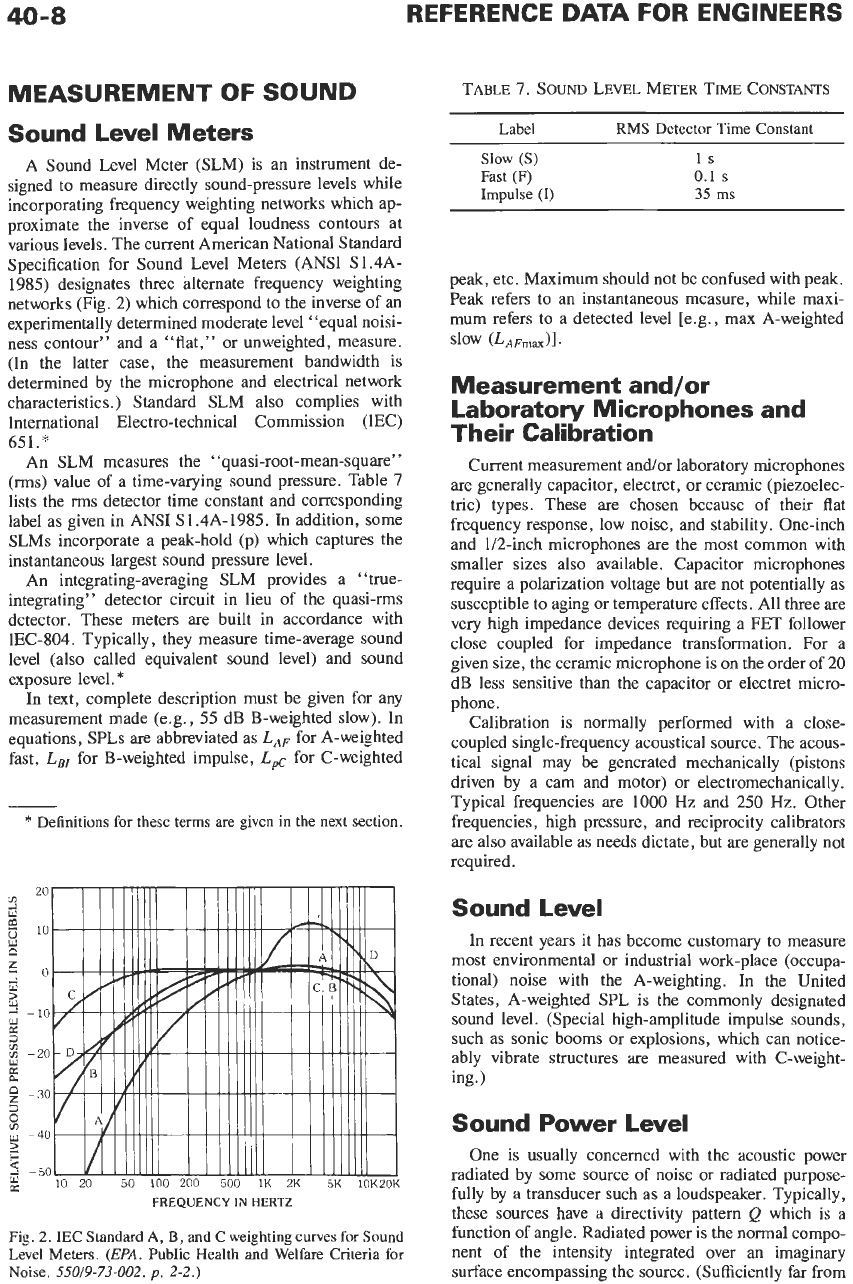
40-8
REFERENCE DATA FOR ENGINEERS
MEASUREMENT
OF
SOUND
Sound Level Meters
A Sound Level Meter (SLM) is an instrument de-
signed to measure directly sound-pressure levels while
incorporating frequency weighting networks which ap-
proximate the inverse of equal loudness contours at
various levels. The current American National Standard
Specification for Sound Level Meters (ANSI S1.4A-
1985) designates three alternate frequency weighting
networks (Fig.
2)
which correspond to the inverse of an
experimentally determined moderate level “equal noisi-
ness contour” and a “flat,” or unweighted, measure.
(In the latter case, the measurement bandwidth is
determined by the microphone and electrical network
characteristics
.)
Standard SLM also complies with
International Electro-technical Commission (IEC)
651.*
An SLM measures the “quasi-root-mean-square”
(rms) value of a time-varying sound pressure. Table
7
lists the rms detector time constant and corresponding
label as given in ANSI S1.4A-1985. In addition, some
SLMs incorporate a peak-hold (p) which captures the
instantaneous largest sound pressure level.
An integrating-averaging SLM provides a “true-
integrating” detector circuit in lieu of the quasi-rms
detector. These meters are built in accordance with
IEC-804. Typically, they measure time-average sound
level (also called equivalent sound level) and sound
exposure level.
*
In text, complete description must be given for any
measurement made (e&,
55
dB B-weighted slow). In
equations, SPLs are abbreviated as
LA,
for A-weighted
fast,
L,
for B-weighted impulse,
LPc
for C-weighted
*
Definitions for these terms are given
in
the next section.
FREQUENCY
IN
HERTZ
Fig.
2.
IEC
Standard
A,
B,
and
C
weighting curves for Sound
Level Meters.
(EPA.
Public Health and Welfare Criteria for
Noise.
550/9-73-002.
p.
2-2.)
TABLE
7.
SOUND
LEVEL METER TIME CONSTANTS
Label RMS Detector Time Constant
Slow
(S)
Fast
(F)
Impulse
(I)
1s
0.1
s
35
ms
peak, etc. Maximum should not be confused with peak.
Peak refers to an instantaneous measure, while maxi-
mum refers to a detected level [e.g., max A-weighted
slow
(LAFrnax)l.
Measurement and/or
Laboratory Microphones and
Their Calibration
Current measurement and/or laboratory microphones
are
generally capacitor, electret, or ceramic (piezoelec-
tric) types. These are chosen because of their flat
frequency response, low noise, and stability. One-inch
and 1/2-inch microphones are the most common with
smaller sizes also available. Capacitor microphones
require a polarization voltage but are not potentially as
susceptible to aging or temperature effects. All three are
very high impedance devices requiring a FET follower
close coupled for impedance transformation. For a
given size, the ceramic microphone is on the order of 20
dB less sensitive than the capacitor or electret micro-
phone.
Calibration is normally performed with a close-
coupled single-frequency acoustical source. The acous-
tical signal may be generated mechanically (pistons
driven by a cam and motor) or electromechanically.
Typical frequencies are
1000
Hz and
250
Hz. Other
frequencies, high pressure, and reciprocity calibrators
are also available as needs dictate, but are generally not
required.
Sound Level
In recent years it has become customary to measure
most environmental or industrial work-place (occupa-
tional) noise with the A-weighting.
In the United
States, A-weighted SPL is the commonly designated
sound level. (Special high-amplitude impulse sounds,
such
as
sonic booms or explosions, which can notice-
ably vibrate structures are measured with C-weight-
ing.)
Sound Power Level
One is usually concerned with the acoustic power
radiated by some source of noise or radiated purpose-
fully by a transducer such as a loudspeaker. Typically,
these sources have a directivity pattern
Q
which
is
a
function
of
angle. Radiated power is the normal compo-
nent of the intensity integrated over an imaginary
surface encompassing the source. (Sufficiently far from
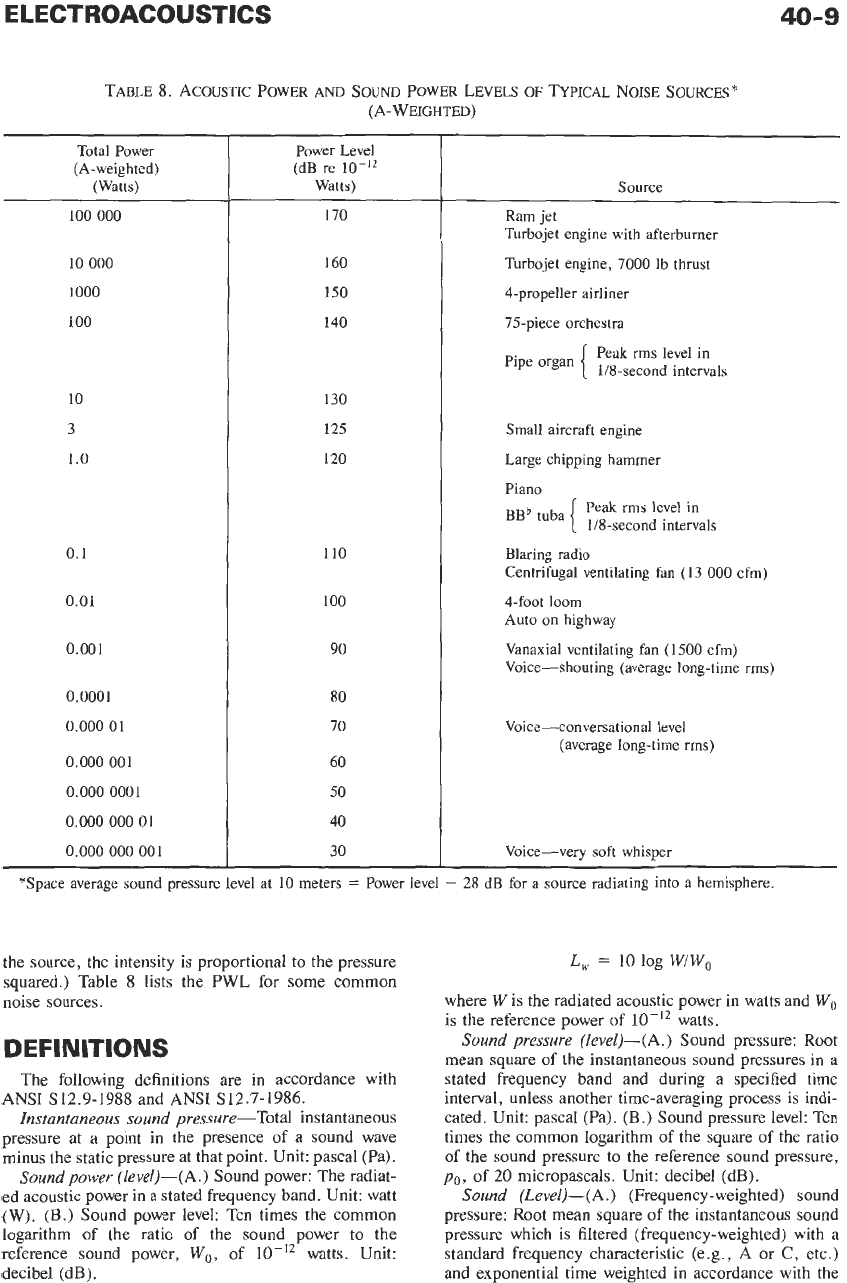
ELECTROACOUSTICS
TABLE
8.
ACOUSTIC POWER
AND
SOUND POWER LEVELS OF TYPICAL NOISE SOURCES*
(A- WEIGHTED)
40-9
Total Power
(A-weighted)
(Watts)
100
000
10
000
1000
100
10
3
1.0
0.1
0.01
0.001
0.0001
0.000
01
0.000
001
0.000
0001
0.000
000
01
0.000
000
001
Power Level
(dB re
lo-'*
Watts)
170
160
150
140
130
125
120
110
100
90
80
70
60
50
40
30
Source
Ram jet
Turbojet engine with afterburner
Turbojet engine, 7000 lb thrust
4-propeller airliner
75-piece orchestra
Peak rms level in
li8-second intervals
Pipe organ
Small aircraft engine
Large chipping hammer
Piano
BBb tuba
[
Blaring radio
Centrifugal ventilating fan (13
000
cfm)
4-fOOt loom
Auto on highway
Vanaxial ventilating fan (1500 cfm)
Voice-shouting (average long-time rms)
Peak rms level in
1/8-second intervals
Voice-conversational level
(average long-time rms)
Voice-very soft whisper
*Space average sound pressure level at
10
meters
=
Power level
-
28
dB
for
a
source radiating into a hemisphere.
the source, the intensity is proportional to the pressure
squared.) Table
8
lists the PWL for some common
noise sources.
DEFINITIONS
The following definitions are in accordance with
ANSI
S12.9-1988
and ANSI
S12.7-1986.
Instantaneous
sound
pressure-Total instantaneous
pressure at a point in the presence of a sound wave
minus the static pressure at that point. Unit: pascal (Pa).
Sound
power (level)-(A,) Sound power: The radiat-
ed acoustic power in a stated frequency band. Unit: watt
(W). (B.) Sound power level: Ten times the common
logarithm
of
the ratio of the
sound
power to the
reference sound power,
Wo,
of
lo-''
watts. Unit:
decibel (dB).
L,
=
10
log
WIWO
where
W
is the radiated acoustic power in watts and
Wo
is the reference power of
lo-'*
watts.
Sound
pressure (level)-(A.) Sound pressure: Root
mean square of the instantaneous sound pressures
in
a
stated frequency band and during a specified time
interval, unless another time-averaging process is indi-
cated. Unit: pascal (Pa).
(B.)
Sound pressure level: Ten
times the common logarithm of the square of the ratio
of the sound pressure to the reference sound pressure,
po,
of
20
micropascals. Unit: decibel (dB).
Sound (Level)-(A.) (Frequency-weighted) sound
pressure: Root mean square of the instantaneous sound
pressure which is filtered (frequency-weighted) with a
standard frequency characteristic (e.g.,
A
or
C,
etc.)
and exponential time weighted in accordance with the
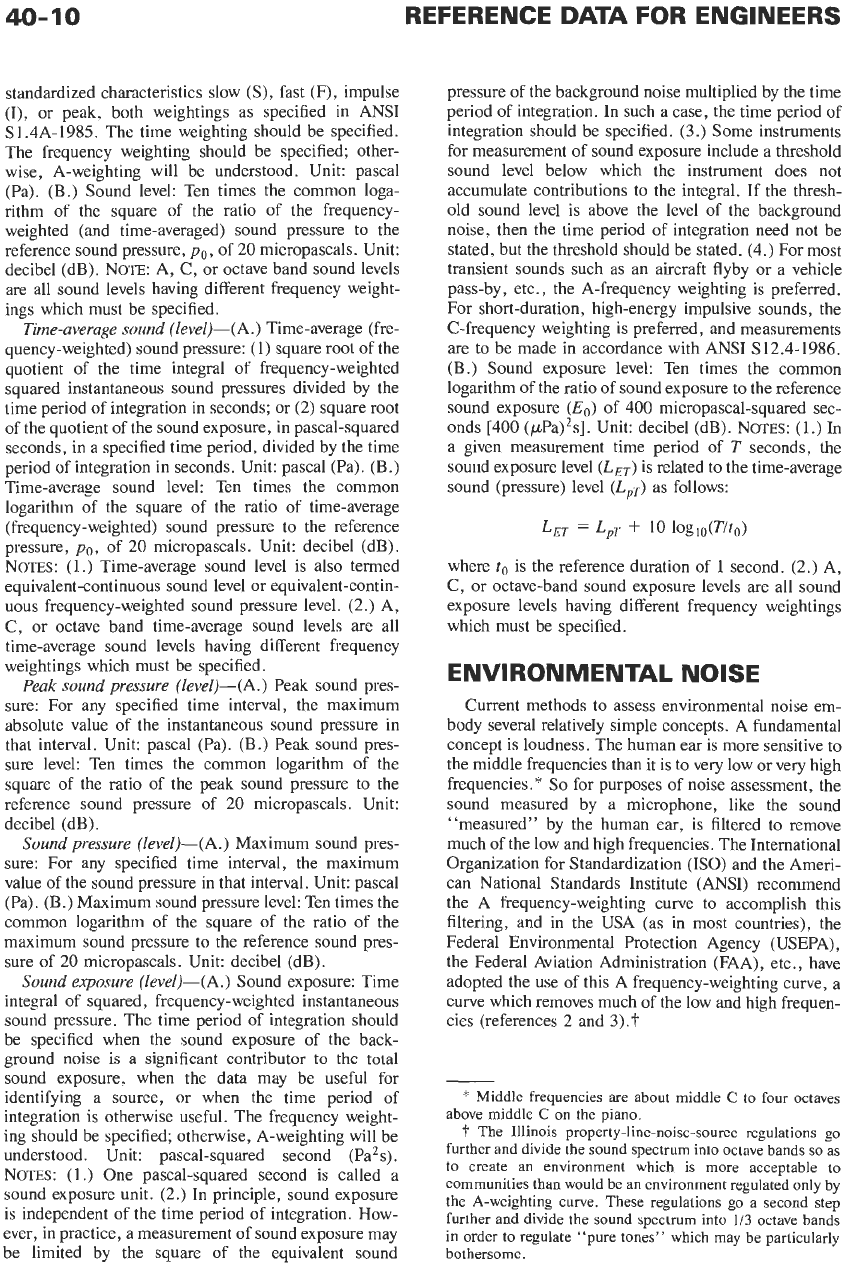
standardized characteristics slow
(S),
fast (F), impulse
(I),
or peak, both weightings as specified in ANSI
S1.4A-1985. The time weighting should be specified.
The frequency weighting should be specified; other-
wise, A-weighting will be understood. Unit: pascal
(Pa). (B.) Sound level: Ten times the common loga-
rithm of the square of the ratio of the frequency-
weighted (and time-averaged) sound pressure to the
reference sound pressure,
po,
of 20 micropascals. Unit:
decibel (dB).
NOTE:
A, C, or octave band sound levels
are all sound levels having different frequency weight-
ings which must be specified.
Time-average
sound
(level)-(A.) Time-average (fre-
quency-weighted) sound pressure:
(1)
square root of the
quotient of the time integral of frequency-weighted
squared instantaneous sound pressures divided by the
time period of integration in seconds; or (2) square root
of the quotient of the sound exposure, in pascal-squared
seconds, in a specified time period, divided by the time
period of integration in seconds. Unit: pascal (Pa). (B.)
Time-average sound level: Ten times the common
logarithm of the square
of
the ratio of time-average
(frequency-weighted) sound pressure to the reference
pressure, po, of 20 micropascals. Unit: decibel (dB).
NOTES:
(1.)
Time-average sound level is also termed
equivalent-continuous sound level or equivalent-contin-
uous
frequency-weighted sound pressure level.
(2.)
A,
C,
or
octave band time-average sound levels are all
time-average sound levels having different frequency
weightings which must be specified.
Peak
sound
pressure (level)-(A.) Peak sound pres-
sure: For any specified time interval, the maximum
absolute value of the instantaneous sound pressure in
that interval. Unit: pascal (Pa). (B.) Peak sound pres-
sure level: Ten times the common logarithm of the
square of the ratio of the peak sound pressure to the
reference sound pressure of 20 micropascals
.
Unit:
decibel (dB)
.
Sound
pressure (level)-(A.) Maximum sound pres-
sure: For any specified time interval, the maximum
value of the sound pressure in that interval. Unit: pascal
(Pa).
(B.)
Maximum sound pressure level: Ten times the
common logarithm of the square of the ratio of the
maximum sound pressure to the reference sound pres-
sure of
20
micropascals. Unit: decibel (dB).
Sound
exposure (level)-(A.) Sound exposure: Time
integral of squared, frequency-weighted instantaneous
sound pressure. The time period of integration should
be specified when the sound exposure of the back-
ground noise is a significant contributor to the total
sound exposure, when the data may be useful for
identifying a source, or when the time period of
integration is otherwise useful. The frequency weight-
ing should be specified; otherwise, A-weighting will be
understood. Unit: pascal-squared second (Pa’s).
NOTES:
(1.)
One pascal-squared second is called a
sound exposure unit.
(2.)
In principle, sound exposure
is independent
of
the time period of integration. How-
ever,
in
practice, a measurement of sound exposure may
be limited by the square of the equivalent sound
pressure
of
the background noise multiplied by the time
period of integration. In such a case, the time period of
integration should be specified.
(3
.)
Some instruments
for measurement of sound exposure include a threshold
sound level below which the instrument does not
accumulate contributions to the integral. If the thresh-
old sound level is above the level of the background
noise, then the time period of integration need not be
stated, but the threshold should be stated. (4.) For most
transient sounds such as an aircraft flyby or a vehicle
pass-by
,
etc., the A-frequency weighting is preferred.
For short-duration, high-energy impulsive sounds, the
C-frequency weighting is preferred, and measurements
are to be made in accordance with ANSI S12.4-1986.
(B.) Sound exposure level: Ten times the common
logarithm of the ratio of sound exposure to the reference
sound exposure
(Eo)
of
400
micropascal-squared sec-
onds
[400
(~Pa)~s]. Unit: decibel (dB).
NOTES:
(1.)
In
a given measurement time period of
T
seconds, the
sound exposure level
(LET)
is related to the time-average
sound (pressure) level
(LpT)
as follows:
where
to
is the reference duration of
1
second.
(2.)
A,
C, or octave-band sound exposure levels are all sound
exposure levels having different frequency weightings
which must be specified.
ENVIRONMENTAL NOISE
Current methods to assess environmental noise em-
body several relatively simple concepts. A fundamental
concept is loudness. The human ear is more sensitive to
the middle frequencies than it is to very low or very high
frequencies.*
So
for purposes of noise assessment, the
sound measured by a microphone, like the sound
“measured” by the human ear, is filtered to remove
much of the low and high frequencies. The International
Organization for Standardization (ISO) and the Ameri-
can National Standards Institute (ANSI) recommend
the A frequency-weighting curve to accomplish this
filtering, and in the USA (as in most countries), the
Federal Environmental Protection Agency (USEPA),
the Federal Aviation Administration (FAA), etc., have
adopted the use of this A frequency-weighting curve, a
curve which removes much of the low and high frequen-
cies (references
2
and
3).t
*
Middle frequencies
are
about middle
C
to four octaves
above middle
C
on
the piano.
t
The Illinois property-line-noise-source regulations go
further and divide the sound spectrum into octave bands
so
as
to create an environment which is more acceptable to
communities than would be an environment regulated only by
the A-weighting cum. These regulations go a second step
further and divide the sound spectrum into
113
octave bands
in order to regulate “pure tones” which may be particularly
bothersome.
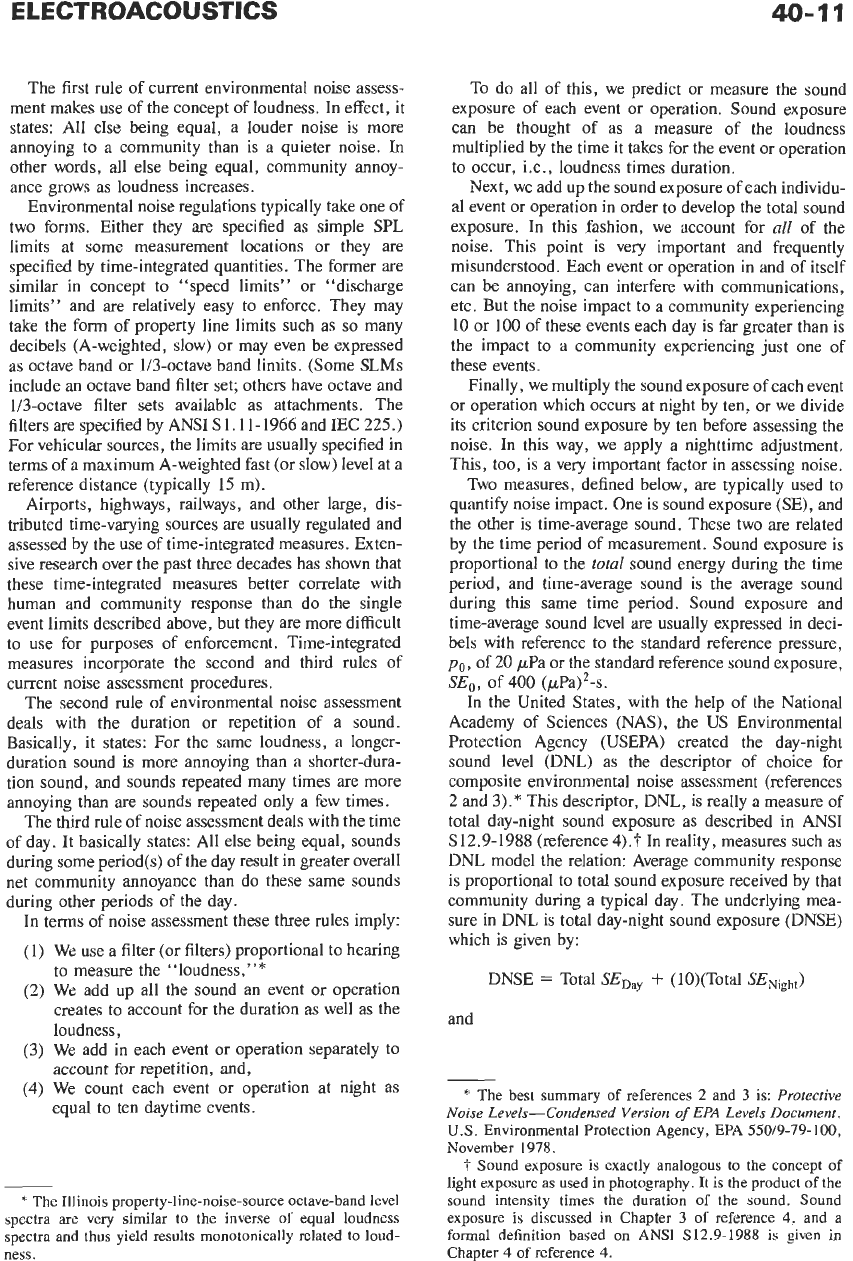
40-11
The first rule of current environmental noise assess-
ment makes use of the concept
of
loudness. In effect, it
states: All else being equal, a louder noise is more
annoying to a community than is a quieter noise. In
other words, all else being equal, community annoy-
ance grows as loudness increases.
Environmental noise regulations typically take one of
two forms. Either they are specified as simple SPL
limits at some measurement locations or they are
specified by time-integrated quantities. The former are
similar in concept to “speed limits” or “discharge
limits” and are relatively easy
to
enforce. They may
take the form of property line limits such as
so
many
decibels (A-weighted, slow) or may even be expressed
as octave band or 1/3-octave band limits. (Some SLMs
include an octave band filter set; others have octave and
1/3-octave filter sets available as attachments. The
filters are specified by ANSI
S
1.1 1- 1966 and IEC
225
.)
For vehicular sources, the limits are usually specified in
terms of a maximum A-weighted fast (or slow) level at a
reference distance (typically
15
m).
Airports, highways, railways, and other large, dis-
tributed time-varying sources are usually regulated and
assessed by the use of time-integrated measures. Exten-
sive research over the past three decades has shown that
these time-integrated measures better correlate with
human and community response than do the single
event limits described above, but they are more difficult
to use for purposes
of
enforcement, Time-integrated
measures incorporate the second and third rules of
current noise assessment procedures.
The second rule of environmental noise assessment
deals with the duration or repetition of a sound.
Basically, it states: For the same loudness, a longer-
duration sound is more annoying than a shorter-dura-
tion sound, and sounds repeated many times are more
annoying than are sounds repeated only a few times.
The third rule of noise assessment deals with the time
of day. It basically states: All else being equal, sounds
during some period(s) of the day result in greater overall
net community annoyance than do these same sounds
during other periods of the day.
In terms of noise assessment these three rules imply:
We use a filter (or filters) proportional to hearing
to measure the “loudness,”*
We add up all the sound an event or operation
creates to account for the duration as well as the
loudness,
We add in each event or operation separately to
account
for
repetition, and,
We count each event or operation at night as
equal to ten daytime events.
*
The Illinois property-line-noise-source octave-band level
spectra are very similar to the inverse of equal loudness
spectra and thus yield results monotonically related to loud-
ness.
To do all of this, we predict or measure the sound
exposure of each event or operation. Sound exposure
can be thought of as a measure of the loudness
multiplied by the time it takes for the event or operation
to occur, Le., loudness times duration.
Next, we add up the sound exposure of each individu-
al
event or operation in order to develop the total sound
exposure. In this fashion, we account for
all
of the
noise. This point is very important and frequently
misunderstood. Each event or operation in and of itself
can be annoying, can interfere with communications,
etc. But the noise impact to a community experiencing
10
or 100 of these events each day
is
far greater than is
the impact to a community experiencing just one of
these events.
Finally, we multiply the sound exposure of each event
or operation which occurs at night by ten, or we divide
its criterion sound exposure by ten before assessing the
noise. In this way, we apply a nighttime adjustment.
This, too, is a very important factor in assessing noise.
Two measures, defined below, are typically used to
quantify noise impact. One is sound exposure
(SE),
and
the other is time-average sound. These two are related
by the time period of measurement. Sound exposure is
proportional to the
total
sound energy during the time
period, and time-average sound is the average sound
during this same time period. Sound exposure and
time-average
sound
level
are
usually expressed in deci-
bels with reference to the standard reference pressure,
p,,
of
20
pPa or the standard reference sound exposure,
SE,,
of
400
(pPa)*-s.
In the United States, with the help of the National
Academy
of
Sciences (NAS), the
US
Environmental
Protection Agency (USEPA) created the day-night
sound level (DNL) as the descriptor of choice for
composite environmental noise assessment (references
2
and
3).*
This descriptor, DNL, is really a measure of
total day-night sound exposure
as
described in ANSI
S12.9-1988 (reference
4).?
In reality, measures such as
DNL model the relation: Average community response
is proportional to total sound exposure received by that
community during a typical day. The underlying mea-
sure in DNL is total day-night sound exposure
(DNSE)
which is given by:
DNSE
=
Total
SED,
+
(10)(Total
SEN,^^^)
and
*
The best summary of references
2
and
3
is:
Protective
Noise Levels-Condensed Version
of
EPA
Levels Document.
U.S. Environmental Protection Agency,
EPA
550/9-79-100,
November
1978.
t
Sound exposure is exactly analogous to the concept
of
light exposure as used in photography. It is the product of the
sound intensity times the duration of the sound. Sound
exposure is discussed in Chapter
3
of
reference
4,
and a
formal definition based on
ANSI
S12.9-1988
is given in
Chapter
4
of reference
4.

40-12
DNL
=
10
log [DNSE/(ToSE,)]
where
To
=
86
400,
the number of seconds in a day
This
is
the actual way we calculate or measure DNL.
ASSESSMENT OF
NOISE
WORKPLACE-INDUSTRIAL
A Sound Level Meter (SLM) set on the A-scale can
be used to assess industrial noise for hearing hazard.
For enforcement purposes, the
US
Department of Labor
(DOL) has set
90
dB
(A)
as the limit for eight hours of
exposure per day. Most industrial noise is not uniform
and continuous, and
so
the regulations of DOL include
procedures for determining the equivalent exposure.
These procedures incorporate a 5-dB trading rule in that
halving the exposure time allows the noise limit to rise
by
5
dB.* The present limits
are
given in Table
9.
As
an alternative to using an SLM to measure
industrial noise exposure, several personnel dosimeters
are available that directly measure a worker's dose
(usually as a percent of the eight-hour limit). These
devices directly incorporate the 5-dB trading rule in
their electronics.
Exposure to impulsive or impact noise should not
exceed
140
dB peak sound pressure level.
*
Most European countries
use
a 3-dB or
equal
energy
rule, and the USAF
uses
a 4-dB rule.
TABLE
9.
PERMISSIBLE
NOISE
EXPOSURES*
Sound Level,
dBA Slow Response Duration per Day, Hours
8
90
6 92
4
95
3
97
2
100
1%
102
1
105
E2
110
Vi
or
less
115
*
When the daily noise exposure is composed of two or
more periods of noise exposure of different levels, their
combined effect should be considered, rather than the indi-
vidual effect of each. If the sum of the following fractions:
CIIT,
+
C21T2
+
.
.
.
Cnic
exceeds unity, where
C,
indi-
cates the total time of exposure at the nth noise level and
T,
indicates the total time of exposure permitted at that level,
then
the
mixed exposure should be considered to exceed the
limit value.
REFERENCE DATA FOR ENGINEERS
SOUND
IN
ENCLOSED
ROOMS*
Indoors, acoustics is of concern for a variety of
reasons. Auditoria, broadcast studios, etc., require low
background noise levels and "good" acoustical design;
offices require varying background levels and communi-
cations capabilities depending on use; and in the
industrial workplace, conservation of hearing and abili-
ty to communicate
are
usually the primary concerns.
In any room, the reverberant SPL increases as the
acoustic power entering the room increases and decreas-
es as sound absorption in the room increases and/or as
sound power flows from the room. Sources of sound
may be internal to rooms, such as machinery or
loudspeakers, or may be external. In the latter case, the
sound flows through walls, windows, ventilation ducts,
etc., from other building spaces or components, or
from outdoors. In either case, the sound field in a room
is composed of two parts, the direct field and the
reverberant field. The direct field of a source is
where,
k
=
(2@c) (rad/m),
p
=
pressure (N/m2),
c
=
speed
of
sound
(ds),
p
=
density of air (kg/m3)
D
=
source strength (m3/s*rad),
Q
=
directivity (rad)?,
r
=
distance from the source (m).
Near a source, the sound field may be very compli-
cated; the pressure and velocity may not be in phase,
and hence the power radiated is not proportional to the
pressure squared. This is particularly a problem when
determining the noise power radiated by machinery in
the industrial environment.
f
By substitution in equation
9,
the direct field intensi-
ty
(Id)
of a source can be written as
Id
=
WQ/4m2
(Eq.
10)
where,
W
=
radiated source power (watts),
*
See,
for example, reference
2.5, 2.6,
or
2.8.
?
The directivity factor of a source is the ratio of the sound
pressure squared, at some fixed distance and specified direc-
tion (such as the axis of a loudspeaker), to the mean-square
sound pressure at the same distance averaged over all direc-
tions from the source. The distance must be great enough
so
that
the
sound appears to diverge spherically from the
effective acoustic center of the source.
$
Sound-intensity meters are a valuable aid in
these
situations, as they indicate the direction of the intensity.
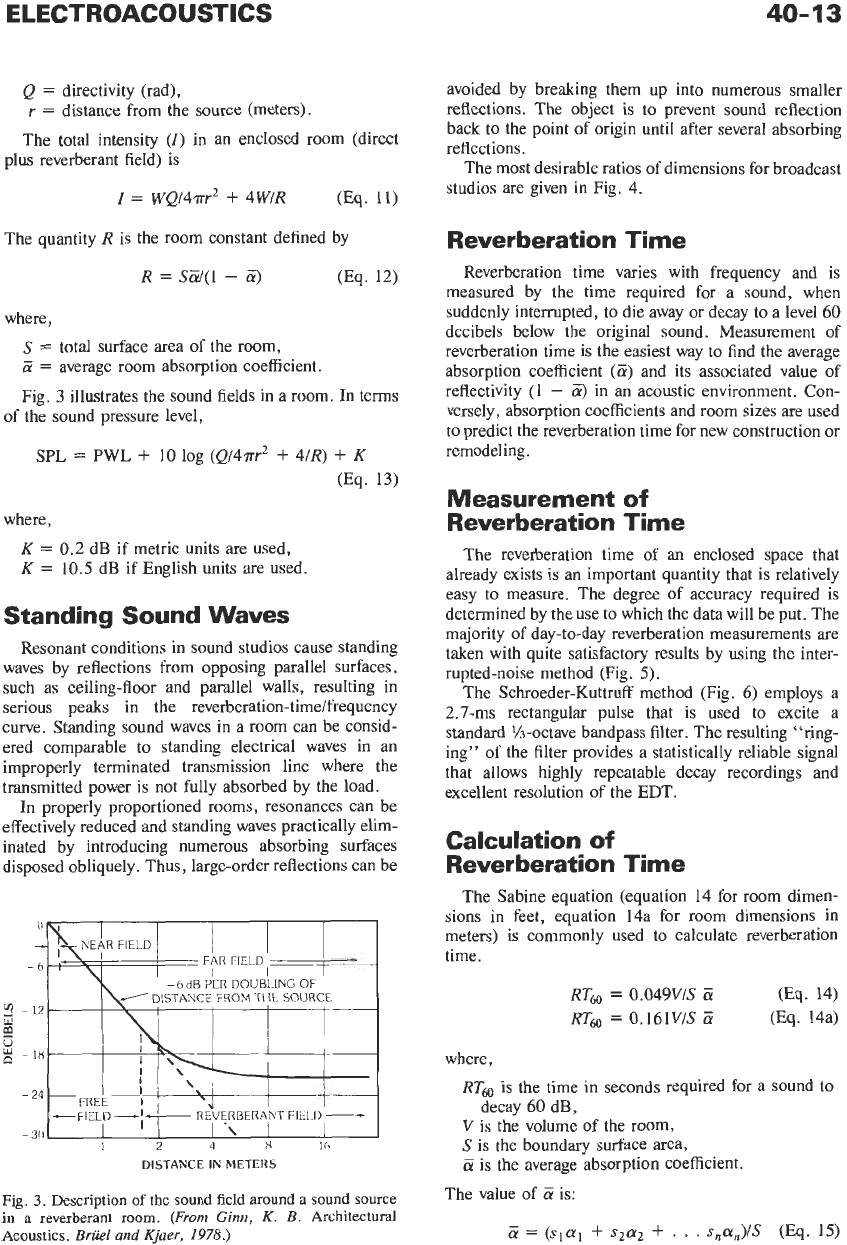
40- 13
Q
=
directivity (rad),
r
=
distance from the source (meters).
The total intensity
(I)
in an enclosed room (direct
plus reverberant field) is
I
=
WQ/4m2
+
4WlR
(Eq.
11)
The quantity
R
is the room constant defined by
R
=
Sa(l
-
Z)
(Eq. 12)
where,
S
=
total surface area of the room,
Z
=
average room absorption coefficient.
Fig. 3 illustrates the sound fields in a room. In terms
of the sound pressure level,
SPL
=
PWL
+
10
log
(Q/4m2
+
4/R)
+
K
(Eq. 13)
where,
K
=
0.2 dB if metric units are used,
K
=
10.5 dB if English units are used.
Standing Sound Waves
Resonant conditions in sound studios cause standing
waves by reflections from opposing parallel surfaces,
such as ceiling-floor and parallel walls, resulting in
serious peaks in the
reverberation-timelfrequency
curve. Standing sound waves in a room can be consid-
ered comparable to standing electrical waves in an
improperly terminated transmission line where the
transmitted power is not fully absorbed by the load.
In properly proportioned rooms, resonances can be
effectively reduced
and
standing waves practically elim-
inated by introducing numerous absorbing surfaces
disposed obliquely. Thus, large-order reflections can be
1
2
4
X
16
DISTANCE IN METERS
Fig.
3.
Description
of
the sound field around a
sound
source
in
a reverberant room.
(From Ginn,
K.
B.
Architectural
Acoustics.
Briiel and Kjaer,
1978.
j
avoided by breaking them up into numerous smaller
reflections. The object is to prevent sound reflection
back to the point of origin until after several absorbing
reflections.
The most desirable ratios of dimensions for broadcast
studios are given in Fig.
4.
Reverberation Time
Reverberation time varies with frequency and is
measured by the time required for a sound, when
suddenly interrupted, to die away or decay to a level
60
decibels below the original sound. Measurement of
reverberation time is the easiest way to find the average
absorption coefficient
(Z)
and its associated value of
reflectivity (1
-
Z)
in an acoustic environment. Con-
versely, absorption coefficients and room sizes are used
to predict the reverberation time for new construction or
remodeling.
Measurement
of
Reverberation Time
The reverberation time of an enclosed space that
already exists is an important quantity that is relatively
easy to measure. The degree of accuracy required is
determined by the use to which the data will be put. The
majority of day-to-day reverberation measurements are
taken with quite satisfactory results by using the inter-
rupted-noise method (Fig.
5).
The Schroeder-Kuttruff method (Fig.
6)
employs a
2.7-ms rectangular pulse that is used to excite a
standard %-octave bandpass filter. The resulting “ring-
ing”
of
the filter provides a statistically reliable signal
that allows highly repeatable decay recordings and
excellent resolution of the EDT.
Calculation
of
Reverberation Time
The Sabine equation (equation
14
for room dimen-
sions
in
feet, equation 14a for room dimensions in
meters) is commonly used to calculate reverberation
time,
RTbo
=
0.049VIS
Z
(Eq.
14)
RT&
=
0.161VlS
Z
(Eq. 14a)
where,
is the time in seconds required for a sound to
decay
60
dB,
V
is the volume
of
the room,
S
is the boundary surface area,
Z
is the average absorption coefficient.
The value
of
Z
is:
Z
=
(s,a,
+
s2a2
+
. . .
s,a,)/S
(Eq. 15)
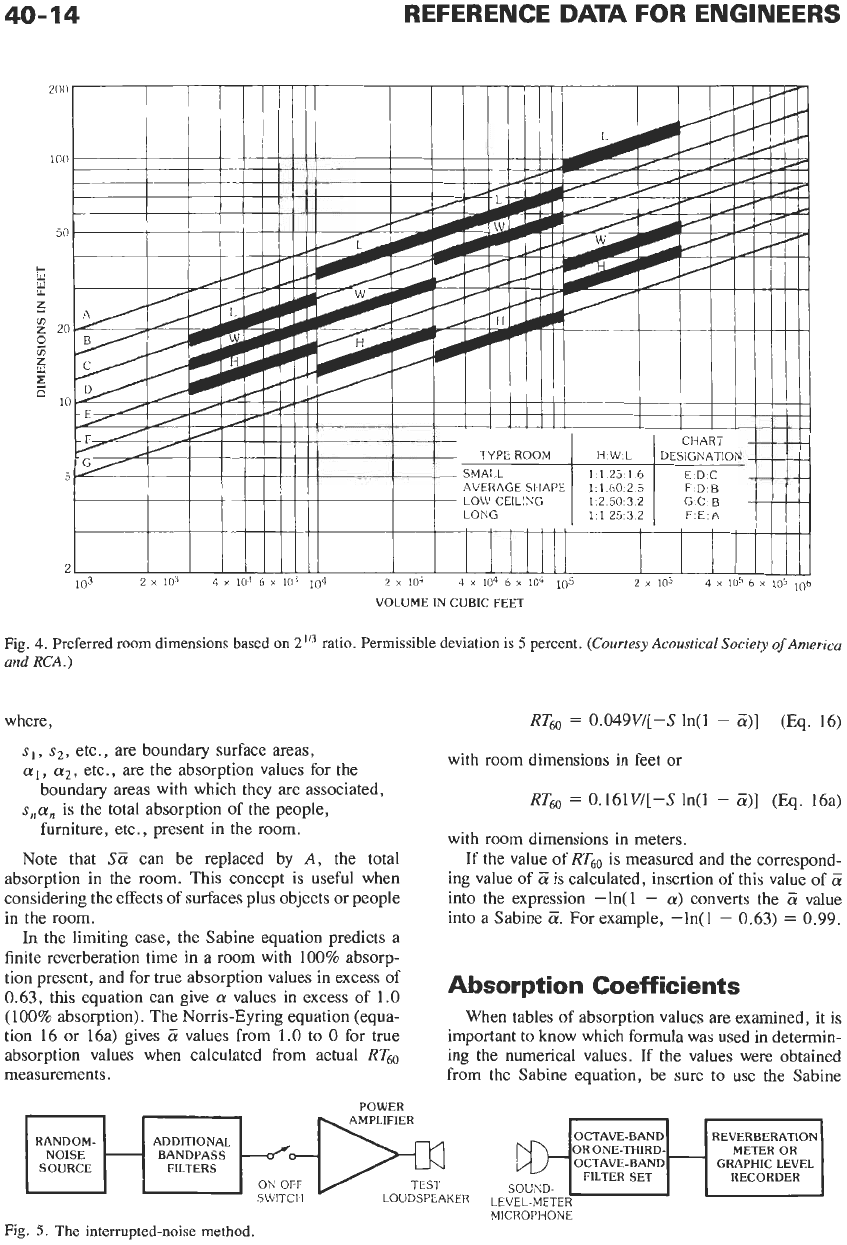
40-14
REFERENCE DATA FOR ENGINEERS
2
it
103
2
x
103
4
x
IO'
LOW CEILING
Y
lo3
104
2
Y
lo4
4
x
IO4
6
x
lo4
105
2
Y
IO5
4
x
IO5
6
x
IO5
106
VOLUME
IN
CUBIC FEET
Fig.
4.
Preferred
room
dimensions based
on
2L'3
ratio. Permissible deviation
is
5
percent.
(Courtesy Acoustical Society
of
America
and
RCA.)
where,
RT60
=
O.O49V/[-S
ln(1
-
CU)]
(Eq. 16)
with room dimensions in feet
ox
s
a,,
cyz,
etc., are the absorption values for the
boundary areas with which they are associated,
s,a,
is the total absorption of the people,
furniture, etc., present in the room.
Note that
SCU
can be replaced by
A,
the total
absorption in the room. This concept is useful when
considering the effects of surfaces plus objects
or
people
in
the room.
In
the limiting case, the Sabine equation predicts a
finite reverberation time in a room with
100%
absorp-
tion present, and for true absorption values in excess
of
0.63, this equation can give
a
values in excess of 1.0
(100% absorption). The Norris-Eyring equation (equa-
tion 16 or 16a) gives
E
values from
l
.O
to
0
for true
absorption values when calculated from actual
RT60
measurements.
s2,
etc., are boundary surface areas,
Ri"60
=
0.161V/[-S ln(1
-
E)]
(Eq. 16a)
with room dimensions in meters.
If the value of
RT60
is measured and the correspond-
ing value of
E
is calculated, insertion of this value of
E
into the expression -In(
1
-
a)
converts the
ii
value
into a Sabine
E.
For example, -ln(l
-
0.63)
=
0.99.
Absorption Coefficients
When tables of absorption values
are
examined, it is
important to know which formula was used in determin-
ing the numerical values. If the values were obtained
from the Sabine equation, be sure to use the Sabine
POWFR
MICROPHONE
Fig.
5.
The
interrupted-noise method.
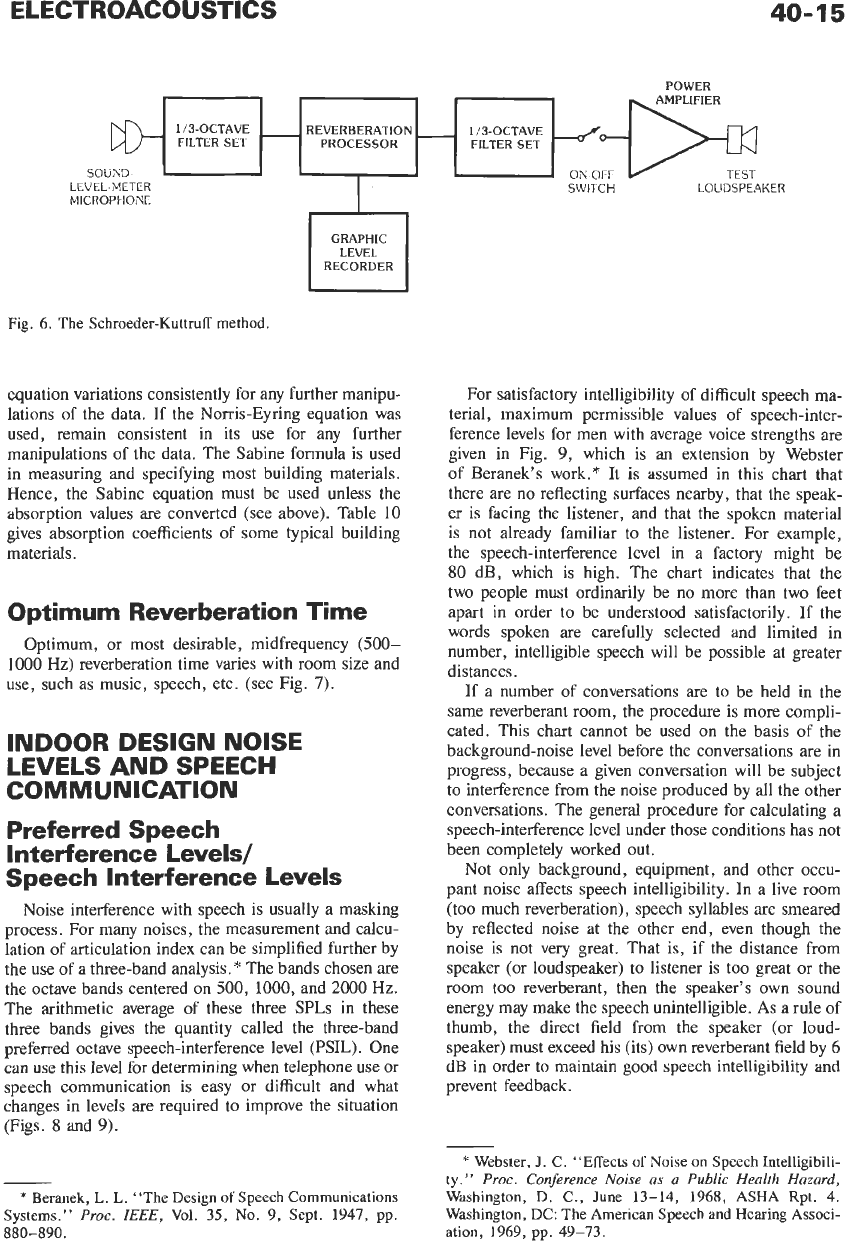
ELECTROACOUSTICS
POWFR
40-15
.
-
. .
-. .
-
REVERBERATION
-
1/3-OCTAVE
4
lI3-OCTAVE
FILTER SET PROCESSOR FILTER SET
I
TEST
LEVEL-METER SWITCH LOUDSPEAKER
MICROPHONE
GRAPHIC
LEVEL
RECORDER
Fig. 6. The Schroeder-Kuttruff method.
equation variations consistently for any further manipu-
lations of the data. If the Norris-Eyring equation was
used, remain consistent in its use for any further
manipulations of the data. The Sabine formula is used
in measuring and specifying most building materials.
Hence, the Sabine equation must be used unless the
absorption values are converted (see above). Table
10
gives absorption coefficients of some typical building
materials.
Optimum Reverberation Time
Optimum, or most desirable, midfrequency
(500-
1000 Hz) reverberation time varies with room size and
use, such as music, speech, etc. (see Fig.
7).
INDOOR DESIGN NOISE
LEVELS AND SPEECH
COMMUNICATION
Preferred Speech
Interference Levels/
Speech Interference Levels
Noise interference with speech is usually a masking
process. For many noises, the measurement and calcu-
lation of articulation index can be simplified further by
the use of a three-band analysis.
*
The bands chosen are
the octave bands centered on
500,
1000, and
2000
Hz.
The arithmetic average of these three
SPLs
in these
three bands gives the quantity called the three-band
preferred octave speech-interference level
(PSIL).
One
can use this level
for
determining when telephone use or
speech communication is easy or difficult and what
changes in levels are required to improve the situation
(Figs.
8
and
9).
For satisfactory intelligibility of difficult speech ma-
terial, maximum permissible values of speech-inter-
ference levels for men with average voice strengths are
given in Fig.
9,
which is an extension by Webster
of Beranek’s work.* It is assumed in this chart that
there are no reflecting surfaces nearby, that the speak-
er is facing the listener, and that the spoken material
is not already familiar to the listener. For example,
the speech-interference level in a factory might be
80
dB, which is high. The chart indicates that the
two people must ordinarily be no more than two feet
apart in order to be understood satisfactorily. If the
words spoken are carefully selected and limited in
number, intelligible speech will be possible at greater
distances.
If a number of conversations are to be held in the
same reverberant room, the procedure is more compli-
cated. This chart cannot be used on the basis of the
background-noise level before the conversations are in
progress, because a given conversation will be subject
to interference from the noise produced by all the other
conversations. The general procedure for calculating a
speech-interference level under those conditions has not
been completely worked out.
Not only background, equipment, and other occu-
pant noise affects speech intelligibility. In a live room
(too much reverberation), speech syllables are smeared
by reflected noise at the other end, even though the
noise is not very great. That is, if the distance from
speaker (or loudspeaker) to listener is too great or the
room too reverberant, then the speaker’s own sound
energy may make the speech unintelligible.
As
a rule of
thumb, the direct field from the speaker (or loud-
speaker) must exceed his (its) own reverberant field by
6
dB
in order to maintain good speech intelligibility and
prevent feedback.
*
Beranek,
L.
L.
“The Design
of
Speech Communications
Systems.”
Proc.
ZEEE,
Vol. 35, No. 9, Sept. 1947, pp.
880-890.
*
Webster,
J.
C. “Effects
of
Noise
on
Speech Intelligibili-
ty.”
Proc. Conference Noise as a Public Health Hazard,
Washington, D. C., June 13-14, 1968, ASHA Rpt. 4.
Washington, DC: The American Speech and Hearing Associ-
ation, 1969, pp. 49-73.
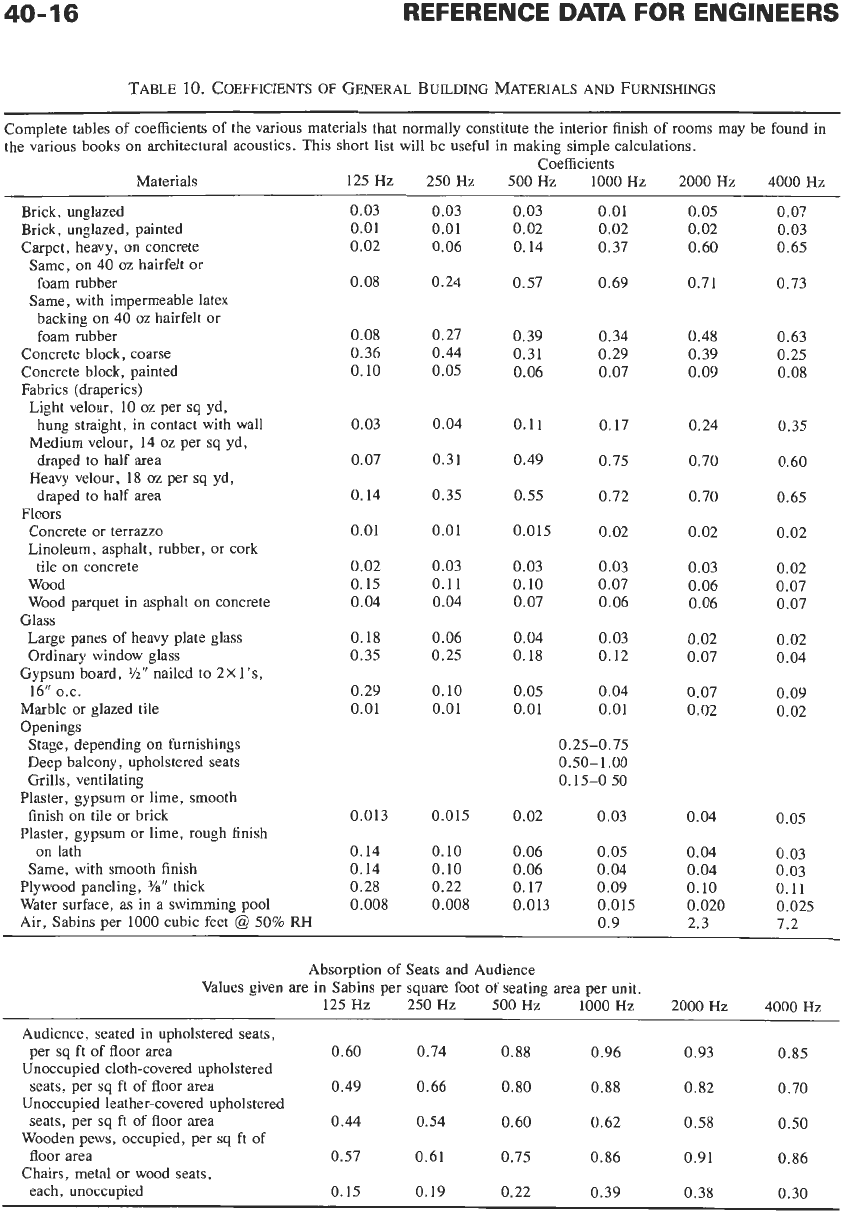
TABLE
10.
COEFFICIENTS OF
GENERAL
BUILDING
MATERIALS
AND
FURNISHINGS
~~
Complete tables of coefficients of the various materials that normally constitute the interior finish of rooms may be found in
the various books
on
architectural acoustics. This short list will be useful in making simple calculations.
Coefficients
Materials
125
Hz
250
Hz
500
Hz
1000
Hz
2000
Hz
4000Hz
Brick, unglazed
Brick, unglazed, painted
Carpet, heavy, on concrete
Same,
on
40
oz hairfelt or
foam rubber
Same,
with impermeable latex
backing
on
40
oz hairfelt or
foam rubber
Concrete block, coarse
Concrete block, painted
Fabrics (draperies)
Light velour,
10
oz per
sq
yd,
Medium velour,
14
oz
per sq yd,
Heavy velour,
18
oz per
sq
yd,
hung straight, in contact with wall
draped to half area
draped to half area
Concrete or terrazzo
Linoleum, asphalt, rubber, or cork
Wood
Wood parquet in asphalt
on
concrete
Large panes of heavy plate glass
Ordinary window glass
Gypsum board,
Yz"
nailed to
2Xl's,
16"
O.C.
Marble or glazed tile
Openings
Floors
tile on concrete
Glass
Stage, depending on furnishings
Deep balcony, upholstered seats
Grills, ventilating
Plaster, gypsum or lime, smooth
finish on tile or brick
Plaster, gypsum or lime, rough finish
on lath
Same,
with smooth finish
Plywood paneling,
%"
thick
Water surface, as in a swimming pool
Air, Sabins per
1000
cubic feet
@
50%
0.03
0.01
0.02
0.08
0.08
0.36
0.10
0.03
0.07
0.14
0.01
0.02
0.15
0.04
0.18
0.35
0.29
0.01
0.013
0.14
0.14
0.28
0.008
RH
0.03
0.01
0.06
0.24
0.27
0.44
0.05
0.04
0.31
0.35
0.01
0.03
0.11
0.04
0.06
0.25
0.10
0.01
0.015
0.10
0.10
0.22
0.008
0.03 0.01
0.02 0.02
0.14 0.37
0.57 0.69
0.39 0.34
0.31 0.29
0.06 0.07
0.11 0.17
0.49 0.75
0.55
0.72
0.015 0.02
0.03 0.03
0.10 0.07
0.07
0.06
0.04 0.03
0.18
0.12
0.05 0.04
0.01 0.01
0.25-0.75
0.15-0.50
0.02 0.03
0.50-
1
.OO
0.06 0.05
0.06 0.04
0.17 0.09
0.013 0.015
0.9
0.05
0.02
0.60
0.71
0.48
0.39
0.09
0.24
0.70
0.70
0.02
0.03
0.06
0.06
0.02
0.07
0.07
0.02
0.04
0.04
0.04
0.10
0.020
2.3
0.07
0.03
0.65
0.73
0.63
0.25
0.08
0.35
0.60
0.65
0.02
0.02
0.07
0.07
0.02
0.04
0.09
0.02
0.05
0.03
0.03
0.11
0.025
7.2
-
Absorption of Seats and Audience
Values given are in Sabins per square foot of seating area per unit.
125
Hz
250
HZ
500Hz 1OOOHz
2000
Hz
4000
Hz
Audience, seated in upholstered seats,
Unoccupied cloth-covered upholstered
Unoccupied leather-covered upholstered
Wooden pews, occupied, per sq ft of
Chairs, metal or wood seats,
per
sq
ft of floor area
0.60 0.74
0.88
0.96 0.93 0.85
seats, per sq ft of floor area
0.49 0.66
0.80
0.88
0.82
0.70
seats, per
sq
ft of floor area
0.44 0.54
0.60 0.62 0.58 0.50
floor area
0.57 0.61
0.75 0.86 0.91 0.86
each, unoccupied
0.15 0.19
0.22 0.39 0.38 0.30
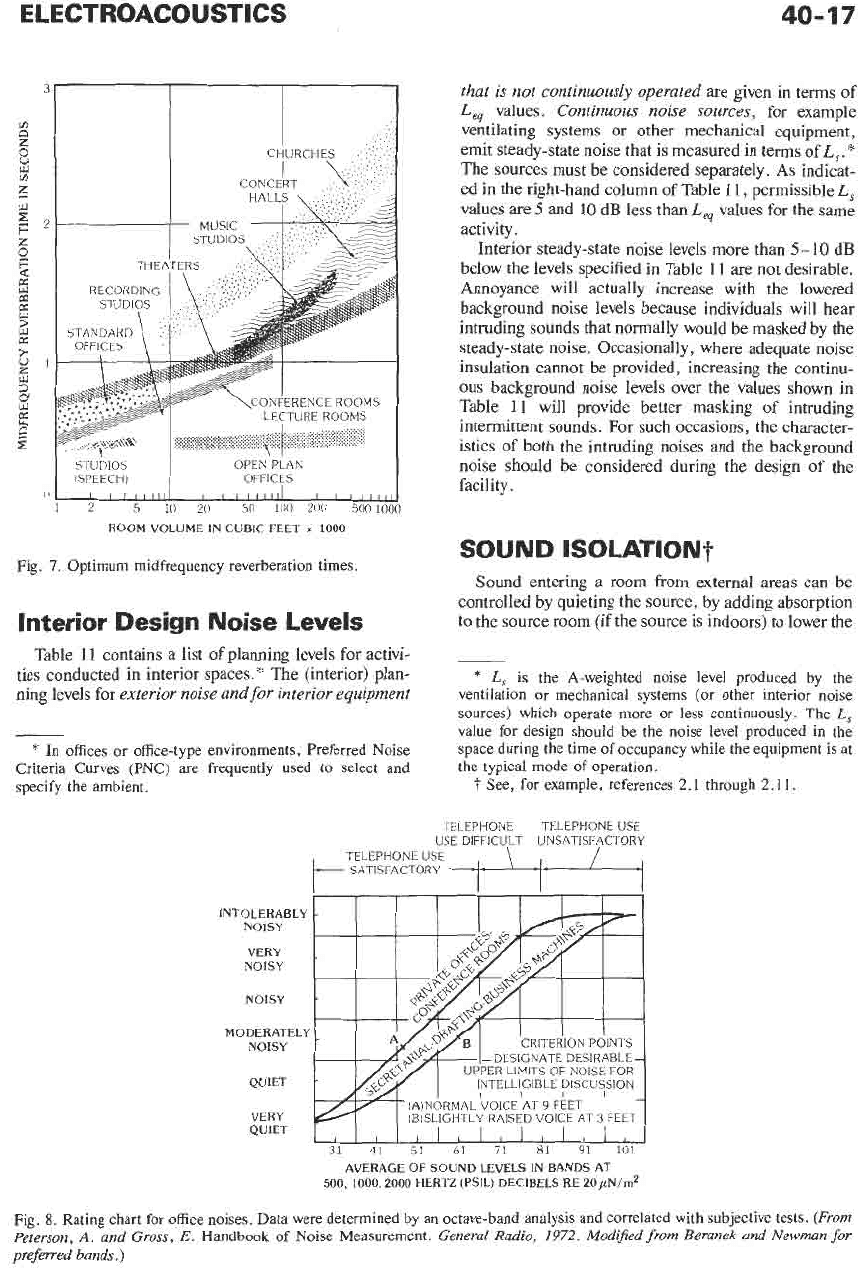
ELECTROACOUSTICS
QUIET
4
40-17
I
I
I
/,IIII1
I
I I
2
L
I
CHURCHES
CONCERT
'\
STUbIOS OPEN PLAN
[SPEECH) OFFICES
I/
I
I
I
IIIII
I
I
I
Illll
I
I
III,~
1
2
5
10
20
SO
100
Z10
500
10
ROOM
VOLUME
IN
CUBIC
FEET
x
1000
Fig.
7.
Optimum midfrequency reverberation times.
Interior Design Noise Levels
Table 11 contains a list of planning levels for activi-
ties conducted in interior spaces.* The (interior) plan-
ning levels for
exterior noise and
for
interior equipment
*
In offices or office-type environments, Preferred Noise
Criteria Curves (PNC) are frequently used to select and
specify
the
ambient.
that is
not
continuously operated
are given in terms of
L,
values.
Continuous noise sources,
for example
ventilating systems or other mechanical equipment,
emit steady-state noise that is measured in terms of
L,.
*
The sources must be considered separately. As indicat-
ed in the right-hand column of Table
11,
permissible
L,
values are
5
and 10 dB less than
Le,
values for the same
activity.
Interior steady-state noise levels more than
5-10
dB
below the levels specified in Table 11 are not desirable.
Annoyance will actually increase with the lowered
background noise levels because individuals will hear
intruding sounds that normally would be masked by the
steady-state noise. Occasionally, where adequate noise
insulation cannot be provided, increasing the continu-
ous
background noise levels over the values shown in
Table 11 will provide better masking of intruding
intermittent sounds. For such occasions, the character-
istics of both the intruding noises and the background
noise should be considered during the design of the
facility.
SOUND
ISOLATIONP
Sound entering a room from external areas can be
controlled by quieting the source, by adding absorption
to the source room (if the source
is
indoors) to lower the
-
*
L,
is
the A-weighted noise level produced by the
ventilation or mechanical systems (or other interior noise
sources) which operate more
or
less continuously. The
L,
value for design should be the noise level produced in the
space during the time of occupancy while the equipment is at
the typical mode of operation.
-F
See, for example, references 2.1 through 2.11.
